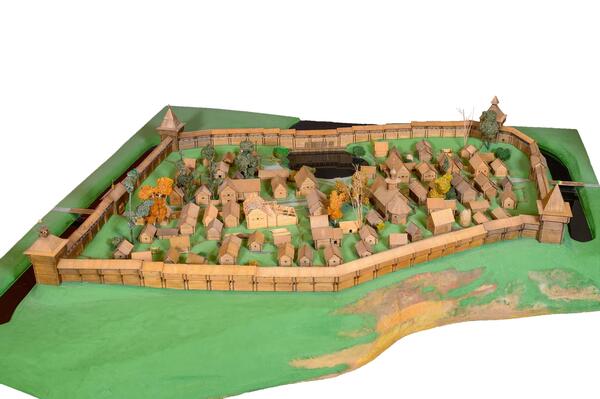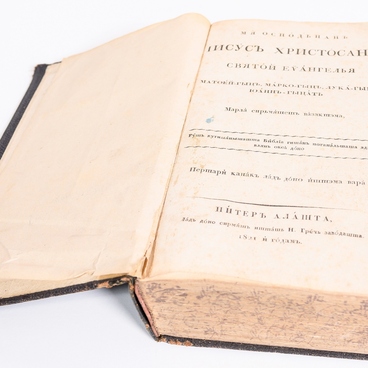The collection of the National Museum of the Republic of Mari El houses a layout that reconstructs the appearance of the Tsaryovokokshaysk fortress in the 17th century. This fortress was the foundation for the future capital of the Mari El Republic — Yoshkar-Ola.
This Russian fortification on the bank of the Malaya Kokshaga River was built in August 1584, during the Third Cheremis War from 1581 to 1585. The fortress served to establish control over the Meadow Mari, who rebelled against the Tsar, and to secure these territories to the Russian state.
The Tsaryovokokshaysk fortress was founded by Prince Dmitry Yeletsky. During the construction, the native inhabitants were either evicted from the territory, as well as the radius of five versts around, or they left on their own not willing to wait to be exiled.
The city was initially called Tsaryov. But it was soon found out that there were other Russian settlements with the same name. Then it was renamed Tsaryov City on the Kokshaga, or Tsaryov Kokshaysky. Soon, the official name of Tsaryovokokshaysk would be established for a long time.
At the beginning of its history, Tsaryovokokshaysk served as a military fortress and at the same time as the center of the uyezd of the same name. As a typical medieval fortification, it was surrounded from all sides by earth ramparts and wooden fortress walls with towers. Three of the walls were surrounded by water moats, and the fourth one was protected by a natural water barrier — the Kokshaga River.
Historians and archaeologists have established that the Tsaryovokokshaysk fortress was located on the territory of the modern Resurrection Church in Yoshkar-Ola and occupied an area of less than one hectare.
Over time, the city lost its military purpose and was turned into the center of crafts and trade, which attracted artisans, merchants, and peasants. The boundaries of the city also went beyond its former limits: a posad and sloboda were formed around it. They were surrounded by fortress walls — the so-called ostrog.
In 1696, Tsaryovokokshaysk completely burned down. After the fire, it was rebuilt, but the fortress walls were not restored: by that time, the Mari Territory was a peaceful area and there was no need for them.
In 1919, the city was renamed Krasnokokshaysk. In 1928, it got a new name — Yoshkar-Ola, which means “red city” in the Mari language.
This Russian fortification on the bank of the Malaya Kokshaga River was built in August 1584, during the Third Cheremis War from 1581 to 1585. The fortress served to establish control over the Meadow Mari, who rebelled against the Tsar, and to secure these territories to the Russian state.
The Tsaryovokokshaysk fortress was founded by Prince Dmitry Yeletsky. During the construction, the native inhabitants were either evicted from the territory, as well as the radius of five versts around, or they left on their own not willing to wait to be exiled.
The city was initially called Tsaryov. But it was soon found out that there were other Russian settlements with the same name. Then it was renamed Tsaryov City on the Kokshaga, or Tsaryov Kokshaysky. Soon, the official name of Tsaryovokokshaysk would be established for a long time.
At the beginning of its history, Tsaryovokokshaysk served as a military fortress and at the same time as the center of the uyezd of the same name. As a typical medieval fortification, it was surrounded from all sides by earth ramparts and wooden fortress walls with towers. Three of the walls were surrounded by water moats, and the fourth one was protected by a natural water barrier — the Kokshaga River.
Historians and archaeologists have established that the Tsaryovokokshaysk fortress was located on the territory of the modern Resurrection Church in Yoshkar-Ola and occupied an area of less than one hectare.
Over time, the city lost its military purpose and was turned into the center of crafts and trade, which attracted artisans, merchants, and peasants. The boundaries of the city also went beyond its former limits: a posad and sloboda were formed around it. They were surrounded by fortress walls — the so-called ostrog.
In 1696, Tsaryovokokshaysk completely burned down. After the fire, it was rebuilt, but the fortress walls were not restored: by that time, the Mari Territory was a peaceful area and there was no need for them.
In 1919, the city was renamed Krasnokokshaysk. In 1928, it got a new name — Yoshkar-Ola, which means “red city” in the Mari language.


